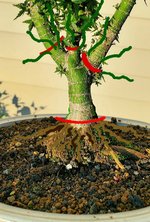I would also disagree with the less-than-position opinions. Not to negate those opinions, by any means. I just think its got potential for a few different directions, and these can be fairly forgiving.
Check out my kotohime thread (and the picture of Lance's tree he posted on my thread!)
I chopped off almost all the branches, leaving a couple nodes on the ones that I saw as part of of the future composition. It was a severe, but not atypical, structural pruning. The following pick was taken a month ago, and its continued to grow rapidly.

I'm going to grow it out for a few years and prune back each fall until the taper is correct, so it looks like a bush now, but those new branches are each probably 18-inches long and some of the new growth is nearing pencil thickness. I don't call that slow growing - it might not gain height quickly, but its supposed to be a compact tree. It grew a ton of leaves and nodes, which is what really counts for bonsai.
For your tree, I see 3 options:
- As @amcoffeegirl suggests, you can leave the structure and chop it shorter. AKA, broom style. Almost ubiquitous growth habit for maples. This wouldn't be my person choice because I don't prefer broom style trees, and you can see maples like this in any neighborhood, park or hiking trail. But it would be the path of least resistance. I'd personally cut a bit shorter than @amcoffeegirl suggested so you get more movement and branches originating from a similar spot.
- Use the front you show in all your pictures but remove the middle and right branch, giving the most movement. If you cut just past the grey line (collar), most maples including kotohime and tridents will typically give you new buds right at the cut point, which is great for healing the cut, but also lets you grow a new branch where you removed the branch. This might sound counterproductive, but the branch on the right is well placed, but too thick. Alternatively, rather than remove that branch completely, cut it back to 1 or 2 nodes.
- Prune as I mentioned above, and rotate the tree 90-degrees clockwise so the remaining branch is facing forward. Or slightly off of 90-degrees to give a bit more movement. This way, the cuts are hidden in the back and the tree is leaning toward the viewer. You get a completely blank slate.
I wouldn't remove both the left and right trunks and leave the middle because you will have a straight trunk and scars on both sides.
I'd also covert the roots a bit more to avoid crow's feet



